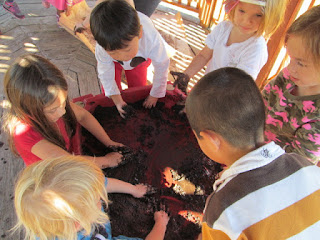For example, we are learning about great artists and different styles of art. Over the next few weeks, you will probably see a good amount of art on here and coming home, as well as all over the walls (and hanging from the ceilings, and in the windows) in our classroom.
First we asked the children what they know about art, this is what they said....
We looked at some pictures of the Pointillism style (at the top of our dry erase board) and talked about how we can make dots. We decided together (or THEY decided, rather) that we could use Q-tips, our fingers, the dot painters, pencils, or markers. We read a really good book called "The Dot" by Peter H. Reynolds. Our first project was using Q-tips....
We also did some color mixing and each child made at least one card with their own personal color on it. I personally think these look amazing together.
Easel painting galore! I think this particular painting is VERY interesting. Obviously a square face...
A little transient art, which is temporary, then left for someone else to add to or change.
More transient art on the light table, with shapes.
Makin' Mud in our outdoor classroom during Gardening time...
And painting with said mud.
More outdoor classroom photos--this is the mud kitchen, or should we say the SAND KITCHEN?!
Reading a story with some good friends outside is really good for whoever wants to join us.
And of course, a little art outside.

















































